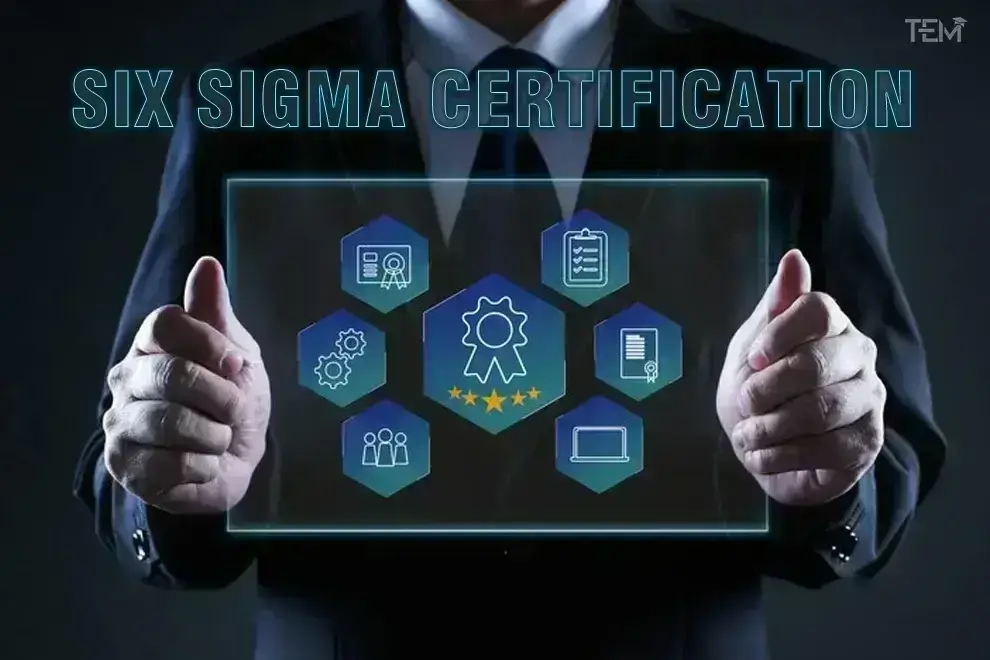Six Sigma is a method that helps organizations improve their processes by identifying and removing defects. It employs data-driven approaches and quality management techniques to achieve near-perfect outcomes. The ultimate goal is to reach six standard deviations between the mean and the nearest specification limit. Also, Six Sigma Certifications demonstrate your expertise in process improvement, which can lead to better job opportunities and career advancement. If you’re a student exploring career-enhancing certifications, understanding what Six Sigma entails and which certification suits your goals can be incredibly beneficial.
Here Are the Top 11 Six Sigma Certifications
Top 11 Certifications to Consider
1. Six Sigma Yellow Belt Certification
If you’re new to Six Sigma and want to understand the methodology’s core concepts, this certification is a good starting point. Indeed, Yellow Belt-certified professionals understand the basic principles of Six Sigma and contribute as team members in project improvement initiatives. They support Green and Black Belts by collecting data and executing smaller projects.
Eligibility Criteria: There are no strict requirements for this entry-level Six Sigma Certification. It’s ideal for beginners who are just starting their journey in quality management.
2. Lean Six Sigma Yellow Belt Certification
It’s perfect for those interested in learning how to enhance business efficiency while maintaining high-quality standards. However, Lean Six Sigma focuses on waste reduction alongside quality improvement. And, certified individuals can identify non-value-added activities in processes and help streamline operations.
Eligibility Criteria: This certification also requires no prior experience and is suitable for those who want to combine Lean principles with Six Sigma.
3. Six Sigma Green Belt Certification
This certification is suitable for professionals who wish to take on leadership roles in project management and process improvement. Green Belt-certified professionals work on projects and lead small teams, applying Six Sigma methodologies to solve quality problems and improve processes.
Eligibility Criteria: Some experience in process management is recommended. Many training programs may ask for basic knowledge of Six Sigma principles.
4. Lean Six Sigma Green Belt Certification
Ideal for those wanting a comprehensive understanding of both Lean and Six Sigma practices, making them well-rounded in quality management. Lean Six Sigma Green Belt focuses on reducing waste and improving process efficiency. It equips professionals with the tools to lead projects that align with business goals.
Eligibility Criteria: Similar to the Six Sigma Green Belt, some experience or foundational understanding of Six Sigma is advantageous.
5. American Society for Quality (ASQ) Six Sigma Certifications
If you’re looking for a reputable certification body with global recognition, ASQ is a great choice. Undoubtedly, ASQ certifications are globally recognized and highly respected. Therefore, they provide a strong theoretical and practical foundation in Six Sigma principles.
Eligibility Criteria: ASQ offers a variety of these certifications, including Yellow, Green, and Black Belt levels. Requirements vary but often include work experience and proof of completed projects.
6. International Association for Six Sigma Certifications (IASSC)
Interestingly, IASSC certifications are known for their thorough examination process, which ensures that certified individuals have a strong grasp of Six Sigma methodologies. Well, IASSC offers standard certifications, including Yellow, Green, and Black Belt, with a rigorous exam to test your knowledge.
Eligibility Criteria: IASSC certifications do not have prerequisites. However, training through an accredited provider is recommended.
7. Council for Six Sigma Certification (CSSC) Programs
It’s an excellent option for students looking for budget-friendly certifications that still hold significant industry value. Furthermore, CSSC is a respected independent certification body that offers flexible and affordable training options, making it accessible for students and professionals.
Eligibility Criteria: CSSC provides free and paid certifications at various levels. There are no strict requirements for many of their programs.
8. Certified Six Sigma Professional (CSSP)
If you prefer hands-on learning and have experience in project management, this certification could boost your career significantly. Also, the certification is practice-oriented, focusing on applying Six Sigma tools for tangible business improvements.
Eligibility Criteria: CSSP requires a certain level of practical experience, as it targets professionals looking to implement Six Sigma tools in real-world scenarios.
9. Six Sigma Black Belt Certification
Surely, this advanced certification is for individuals aiming for leadership roles in quality management and process improvement. Black Belt-certified professionals lead large-scale projects and mentor other team members. They have a deep understanding of Six Sigma principles and statistical tools.
Eligibility Criteria: Candidates should have completed Green Belt training and must often demonstrate significant project management experience.
10. Lean Six Sigma Black Belt Certification
Ideal for professionals who want to drive significant changes in organizational performance and efficiency. Lean Six Sigma Black Belts are experts in eliminating waste and improving process efficiency, using both Lean and Six Sigma methodologies.
Eligibility Criteria: Similar to the Six Sigma Black Belt, prior experience and training at the Green Belt level are often required.
11. Six Sigma Master Black Belt Certification
Undoubtedly, Master Black Belts are the highest level of Six Sigma experts. They are responsible for strategic implementation, mentoring Black and Green Belts, and driving Six Sigma initiatives across an organization. Nevertheless, they possess in-depth knowledge of Six Sigma methodologies and play a key role in aligning process improvement projects with the company’s strategic goals.
Eligibility Criteria: To pursue a Six Sigma Master Black Belt Certification, candidates typically must have a Six Sigma Black Belt Certification and substantial experience leading multiple Six Sigma projects. And, the organizations may also require proof of successful project completions and a solid understanding of advanced statistical analysis.
Why Obtain a Six Sigma Certification?
- Six Sigma-certified professionals are in high demand. They can work in various industries, including manufacturing, healthcare, IT, finance, and logistics.
- Certified Six Sigma professionals often command higher salaries than their non-certified peers. Studies suggest that individuals with certifications see a salary boost of up to 40%.
- Six Sigma training equips you with analytical skills to solve complex business problems effectively.
- Certified professionals can contribute significantly to improving a company’s efficiency and productivity, making them valuable assets. For example, General Electric famously saved over $12 billion in five years through Six Sigma initiatives.
End Note
Obtaining Six Sigma Certifications can be a transformative step in your career, opening doors to higher salaries, leadership roles, and valuable networking opportunities. Whether you’re just starting or looking to advance your career, there are Certifications that are tailored to your needs. Take time to evaluate your career goals and choose a certification that aligns with your professional aspirations. Remember, investing in your skills today can yield long-term career benefits. Furthermore, if you found this blog helpful, share it with all your friends and guide them through their journey to great heights.
FAQs
What is a Six Sigma Certification?
Six Sigma Certification is a well-regarded certification that provides professionals with the skills to improve business processes, minimize waste, and enhance quality using data-driven strategies. This certification can boost your career prospects, as many companies value the efficiency and problem-solving skills that come with Six Sigma training.
What is the difference between Six Sigma Certification and Lean Six Sigma Certification?
While Six Sigma emphasizes eliminating defects and improving quality using statistical analysis, Lean focuses on streamlining operations by removing unnecessary steps or waste. Lean Six Sigma integrates both approaches to optimize processes effectively.
How to Choose the Right Six Sigma Certification?
Among all the 6 Sigma certifications, selecting the appropriate one depends on your career goals and your role in your organization:
- Beginners: Start with White or Yellow Belt to grasp the fundamentals.
- Intermediate Professionals: Green Belt is ideal if you aim to manage projects and lead teams.
- Senior Leaders: Opt for Black Belt or Master Black Belt if you’re focused on strategic impact and mentoring.
How Has Six Sigma Evolved Since Its Creation?
Six Sigma was created by Bill Smith at Motorola in 1986 to make manufacturing better and reduce errors. It became famous in the 1990s when Jack Welch used it at General Electric, applying it to areas like customer service and office tasks. Six Sigma also uses statistical process control (SPC) to watch for problems and suggest fixes.










